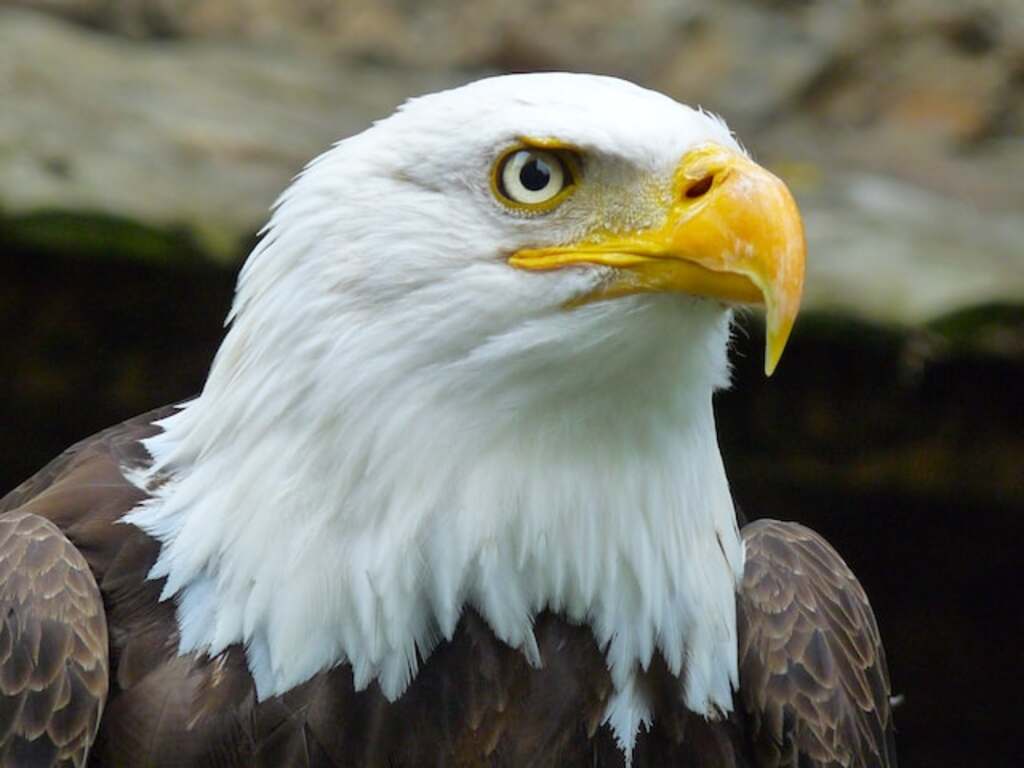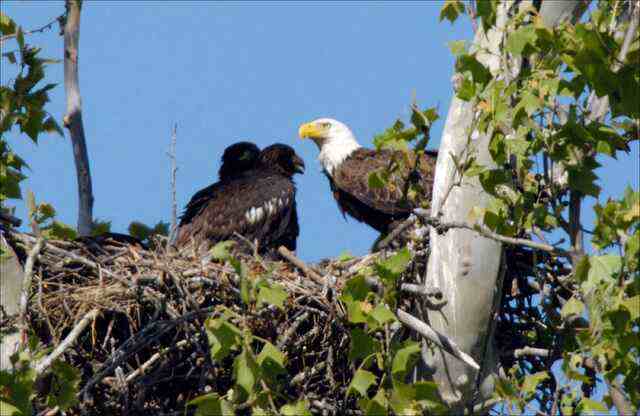In the natural world, the transformation of colors serves as a captivating metaphor for the passage of time. When Do Eagles Heads Turn White?
Explore this mesmerizing phenomenon as we delve into the intricacies of the majestic eagle’s head color change.
Discover the factors influencing this captivating transformation, from melanin’s role to the symbolism it holds.
Join us on a scientific journey, appreciating the beauty and significance of the eagle’s white-headed appearance, while emphasizing the importance of conservation efforts for these remarkable creatures.
Table of Contents
- 1 Key Takeaways
- 2 When Do Eagles Heads Turn White
- 3 Introduction to Eagle’s Head Color Change
- 4 The Life Cycle of Eagles
- 5 Factors Influencing Head Color Change
- 6 The Role of Melanin in Plumage Color
- 7 Age at which Eagles’ Heads Turn White
- 8 Variations in Head Color among Eagle Species
- 9 Other Physical Changes in Aging Eagles
- 10 Significance of White Head for Eagles
- 11 Conservation and Protection of Bald Eagles
- 12 Myths and Legends Surrounding Eagle’s Head Color Change
- 13 Conclusion: Appreciating the Beauty and Symbolism of White-Headed Eagles
- 14 Frequently Asked Questions
- 14.1 What is the average lifespan of an eagle?
- 14.2 How do eagles develop their white head feathers?
- 14.3 Are there any health issues or diseases associated with eagles’ head color change?
- 14.4 Is it possible for an eagle’s head to turn white at a different age than usual?
- 14.5 How do eagles’ head color changes affect their mating behavior?
- 15 Author
Key Takeaways
- The timing and intensity of an eagle’s head color change from dark to white is influenced by factors such as age, food resources, overall health, climate change, and genetics.
- Hormonal changes, diet and nutrition, and sunlight exposure play a role in determining the coloration of an eagle’s head feathers.
- Adequate protein intake, essential vitamins and minerals, and avoiding environmental contaminants are important for eagle nutrition and can impact the color change.
- The white plumage on an eagle’s head serves as a visual cue for maturity, dominance, and reproductive fitness, and is involved in communication, mate selection, and hierarchical displays within eagle communities.

When Do Eagles Heads Turn White
Eagles’ heads turn white due to a reduction in melanin production as they mature. Melanin, responsible for coloration, diminishes gradually, leading to the change from dark to white plumage.
This transformation signals their adulthood and breeding readiness at around four to five years of age, a process called “progressive graying.”
Introduction to Eagle’s Head Color Change
The transformation of an eagle’s head color from dark to white occurs as a notable physical manifestation, akin to the emergence of dawn breaking through the darkness of night.
This unique phenomenon is observed in various eagle populations across different regions, and it is influenced by a combination of environmental factors.
One of the key factors contributing to the change in head color is the age of the eagle. Juvenile eagles typically have dark heads, which gradually transition to a lighter color as they mature.
Additionally, the availability of food resources and the overall health of the eagle population can impact the timing and intensity of the color change.
Understanding the intricate relationship between these environmental factors and the head color change in eagles contributes to our knowledge of their life cycle.
The Life Cycle of Eagles
During their life cycle, eagles undergo a transformation where their head feathers change color to a distinct hue.
This change in coloration is influenced by various factors, including the impact of climate change and the role of genetics.
Climate change can affect the availability of food sources and alter the habitat of eagles, which in turn can impact their overall health and plumage.
Additionally, genetics play a significant role in determining the coloration of an eagle’s head feathers.
Different genetic variations can result in variations in color, ranging from pure white to shades of gray or brown.
Understanding the interplay between climate change and genetics is crucial for comprehending the complex process of head color change in eagles.
This knowledge can help us identify and mitigate potential threats to eagle populations. Factors influencing head color change will be discussed in the subsequent section.
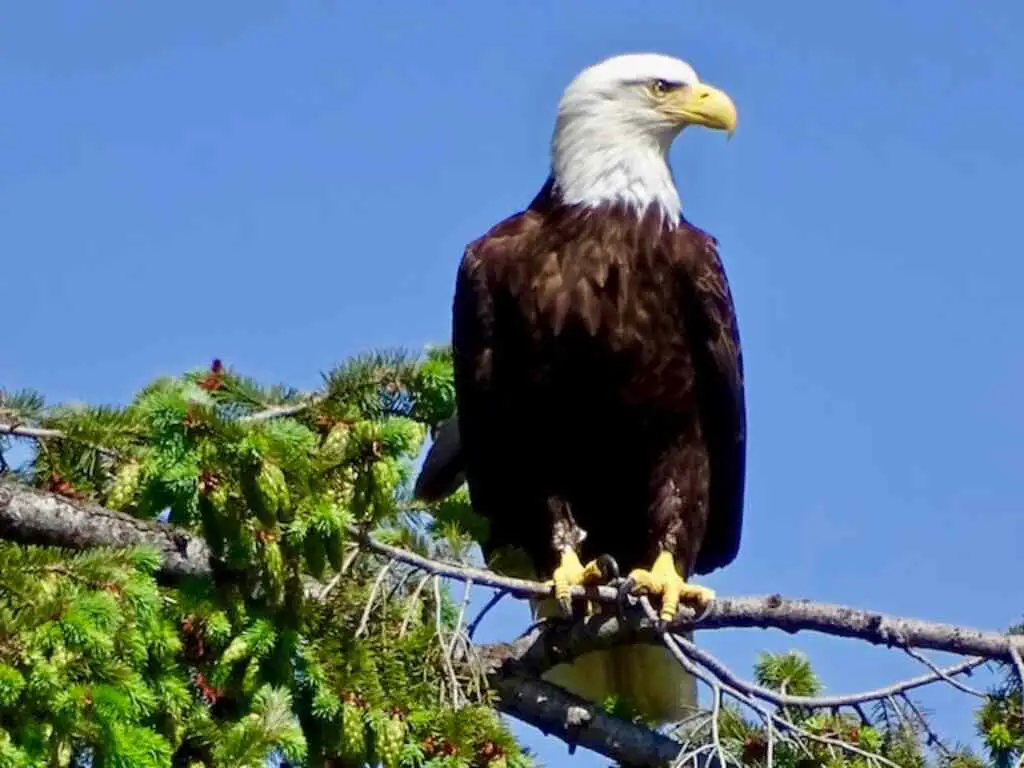
Factors Influencing Head Color Change
The color change in an eagle’s head is influenced by several factors, including hormonal changes, diet and nutrition, and sunlight exposure.
Hormonal changes play a crucial role in the color transformation of an eagle’s head, as shifts in hormone levels can trigger the deposition of pigments that result in the white plumage.
The diet and nutrition of an eagle also contribute to the head color change, as certain nutrients and compounds found in their prey can affect the pigmentation process.
Additionally, sunlight exposure is a critical factor, as ultraviolet radiation can stimulate melanin production and influence the coloration of the eagle’s head.
Hormonal Changes
Hormonal changes in eagles are responsible for the transformation of their heads to white, with approximately 80% of mature eagles exhibiting this distinctive feature.
The process of head color change in eagles is regulated by hormones, specifically the production and release of melanin.
Melanin is a pigment responsible for the coloration of feathers and skin in animals. In eagles, the level of melanin production is influenced by hormonal regulation, which in turn is affected by seasonal patterns.
During certain times of the year, such as breeding season, hormonal changes trigger an increase in melanin production, resulting in a darker head color.
Conversely, during other times, hormonal changes reduce melanin production, leading to the white coloration.
This hormonal regulation of head color change in eagles is a fascinating adaptation that allows them to blend in with their surroundings and enhance their survival.
Moving on to the next section, diet and nutrition also play a crucial role in the overall health and appearance of eagles.
Diet and Nutrition
Diet and nutrition have a significant impact on the overall health and appearance of eagles, influencing their physical condition and vitality. Proper nutrition is essential for maintaining a healthy eagle population. Here are three key factors related to nutrition that affect eagles:
- Adequate protein intake: Eagles require a high protein diet, primarily consisting of fish and small mammals. Protein is crucial for muscle development, feather growth, and overall body maintenance.
- Essential vitamins and minerals: Eagles need a balanced diet to meet their nutritional requirements. Lack of essential vitamins and minerals can lead to various health issues, including weakened immune systems and reduced reproductive success.
- Environmental contaminants: The diet of eagles can be contaminated with pollutants, such as heavy metals and pesticides. These contaminants can accumulate in the eagles’ bodies over time, causing negative health effects.
Considering the influence of diet and nutrition on eagles, it is important to also examine the impact of sunlight exposure on their physical well-being.
Sunlight Exposure
Sunlight exposure plays a crucial role in the overall well-being of eagles. Studies have shown that a lack of adequate sunlight can negatively impact their reproductive success, with a decrease of up to 30% in the number of successful fledglings.
Sunlight exposure provides eagles with essential vitamin D, which is important for their bone development and overall health.
Additionally, sunlight exposure has been found to affect an eagle’s hunting ability.
Research has shown that eagles tend to be more successful in capturing prey when they have been exposed to adequate sunlight.
This may be due to the fact that sunlight enhances their visual acuity and improves their ability to spot and track prey.
Furthermore, exposure to sunlight can also affect the application and effectiveness of sunscreen on an eagle’s feathers, which can have implications for their protection against harmful UV rays.
Transitioning to the next section, the role of melanin in plumage color is another important factor to consider in understanding eagles’ heads turning white.
The Role of Melanin in Plumage Color
The role of melanin in plumage color is a crucial factor in understanding the timing of when eagles’ heads turn white.
Melanin is responsible for the pigmentation of feathers and plays a significant role in determining their color.
The timing of when eagles’ heads turn white is influenced by genetic factors that regulate the production and distribution of melanin in their plumage.
Understanding the role of pigmentation and genetic factors can provide insights into the mechanisms behind this color change phenomenon.
- Melanin production is controlled by a complex interplay of genes and environmental factors.
- The amount and distribution of melanin in the feathers determine their coloration.
- As eagles age, the production of melanin decreases, leading to the gradual whitening of their heads.
- The white plumage serves as a visual cue for maturity and dominance in the eagle population.
The age at which eagles’ heads turn white is closely linked to the decline in melanin production, marking a significant transition in their life cycle.
Age at which Eagles’ Heads Turn White
The phenomenon of eagles’ heads gradually losing their pigmentation as they age marks a significant transition in their life cycle, with the change in coloration serving as a visual indicator of maturity and dominance within the population.
For instance, imagine a majestic eagle perched on a tree branch, its formerly dark and vibrant head now transformed into a striking, pristine hue as it reaches adulthood.
The age at which eagles’ heads turn white can vary among individuals and is influenced by genetic factors.
Some eagles may start showing signs of white plumage on their heads as early as three years old, while others may not exhibit this change until they are five or six years old.
This age variation suggests that genetic factors play a role in determining the timing of this transition.
Understanding the mechanisms behind this age-related change in plumage coloration can provide valuable insights into the aging process and the genetic factors that influence it.
Transitioning to the subsequent section about variations in head color among eagle species, it is important to explore the factors that contribute to the diversity in plumage coloration within and across different eagle species.
Variations in Head Color among Eagle Species
Variations in head color among different eagle species provide a fascinating glimpse into the intricate patterns and hues that adorn these majestic birds.
The color of an eagle’s head is primarily determined by hormonal regulation and influenced by environmental factors.
For instance, the transition from dark to white plumage in bald eagles occurs gradually over several years, beginning at the base of the bill and spreading towards the back of the head.
This process is driven by hormonal changes associated with sexual maturity and breeding.
Additionally, environmental factors such as diet and exposure to sunlight can also affect the intensity and brightness of an eagle’s head color.
Understanding the underlying mechanisms that govern these variations in head color among eagle species contributes to our knowledge of avian physiology and adaptation.
Moving forward, it is important to explore other physical changes in aging eagles, which will be discussed in the subsequent section.
Other Physical Changes in Aging Eagles
One notable aspect to consider regarding the aging process of eagles is the occurrence of various physical changes.
As eagles age, they experience hormonal changes that can lead to alterations in their appearance. For example, the coloration of their feathers may change, becoming duller or lighter.
Additionally, their diet and nutrition play a crucial role in their physical changes.
As eagles age, their ability to hunt and capture prey may decline, which can result in a decrease in their overall body condition.
This can be attributed to a decrease in muscle mass and an increase in fat deposits. These changes in diet and nutrition can also impact the coloration of their feathers.
Overall, it is important to understand the various physical changes that occur in aging eagles in order to better comprehend the significance of a white head for these majestic birds.
Significance of White Head for Eagles
The white head of an eagle holds significance in various aspects of their behavior and social interactions.
Firstly, it plays a crucial role in mate selection. The white head is considered a sign of maturity and is often preferred by potential mates as it indicates a higher level of experience and reproductive fitness.
Additionally, the white head serves as a communication tool for eagles, allowing them to convey their dominance or submission to others in their social group.
Lastly, the white head is involved in hierarchical displays, where eagles use their appearance to establish their position within the group, ensuring efficient resource allocation and minimizing conflict.
Mate Selection
Mate selection in eagles is a fascinating and intricate process, where potential partners engage in a mesmerizing dance of courtship rituals and aerial displays before deciding on a lifelong commitment.
The white head of an eagle plays a significant role in mate selection, as it symbolizes maturity and reproductive fitness.
This physical characteristic is viewed as a desirable trait by potential mates, as it indicates the eagle’s ability to successfully survive and reproduce.
The white feathers on the head also serve as a visual cue during courtship displays, attracting the attention of potential partners and conveying important information about the individual’s health and genetic quality.
Through this visual communication, eagles are able to assess each other’s suitability as mates and make informed decisions.
The white head, therefore, acts as a powerful signal in the mate selection process, ensuring that eagles choose partners that are most likely to produce healthy offspring and contribute to the survival of the species.
This selection process then transitions seamlessly into communication and hierarchical displays within the eagle community.
Communication and Hierarchical Displays
Communication and hierarchical displays among eagles are essential for establishing social order and conveying important information within the community.
Eagles employ various communication techniques to communicate with each other, including vocalizations, body postures, and visual displays.
Vocalizations, such as screeches and calls, are used for long-distance communication, while body postures and visual displays are used for close-range communication.
These displays include stretching of wings, puffing up of feathers, and aggressive postures.
Through these communication techniques, eagles establish dominance hierarchies within their community, with higher-ranking individuals having access to better resources and mating opportunities.
The dominance hierarchy is crucial for maintaining social stability and avoiding conflicts within the eagle population.
Understanding the intricacies of eagle communication and the establishment of dominance hierarchies can provide valuable insights into their social behavior and contribute to the conservation and protection of bald eagles.
Conservation and Protection of Bald Eagles
Conservation efforts have been essential in safeguarding the iconic bald eagle, ensuring its long-term survival and protection. To achieve this, several key strategies have been implemented:
- Habitat preservation: Protecting and restoring the natural habitats of bald eagles is crucial for their survival. This involves conserving nesting sites, ensuring access to clean water sources, and minimizing human disturbance in their habitats.
- Hunting regulations: Strict regulations on hunting and trapping have been implemented to prevent the illegal killing of bald eagles. These regulations aim to maintain a healthy population and prevent further decline.
- Pollution control: Reducing pollution, particularly contaminants such as pesticides and heavy metals, is essential for the well-being of bald eagles. Efforts are made to monitor and control pollution levels to minimize adverse effects on their health and reproductive success.
- Public awareness and education: Educating the public about the importance of bald eagle conservation fosters a sense of responsibility and encourages support for protective measures.
With these conservation efforts in place, the bald eagle population has shown signs of recovery.
Transitioning into the subsequent section, myths and legends surrounding the eagle’s head color change have intrigued people for centuries.
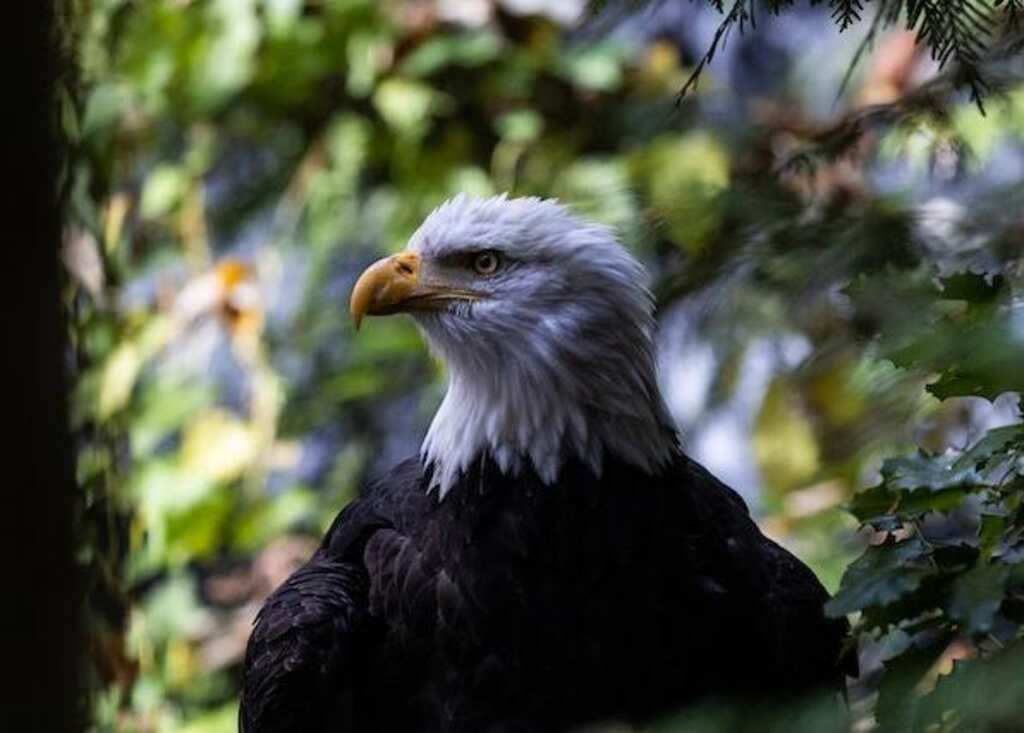
Myths and Legends Surrounding Eagle’s Head Color Change
Myths and legends surrounding the fascinating phenomenon of the bald eagle’s head color change have captivated people’s imaginations for centuries.
In many cultures, the change from dark to white feathers on an eagle’s head is seen as a symbol of wisdom, strength, and spiritual transformation.
These stories often attribute the color change to supernatural powers or divine intervention.
While the actual reason for the change in head color is due to the bird’s maturation process, the symbolism and significance attributed to it have endured throughout history.
To engage the audience further, let’s explore a table that showcases some of the myths and legends surrounding the bald eagle’s head color change:
| Myth/Legend | Culture | Symbolism |
|---|---|---|
| Thunderbird | Native American | Power and protection |
| Garuda | Hinduism | Divine bird and king of birds |
| White-headed Eagle | Norse mythology | Wisdom and connection to the gods |
These tales not only showcase the cultural diversity but also highlight the universal fascination with the white-headed eagles.
Appreciating the beauty and symbolism of these majestic creatures allows us to connect with the rich heritage of human imagination and spirituality.
Conclusion: Appreciating the Beauty and Symbolism of White-Headed Eagles
Appreciating the ethereal transformation of the bald eagle’s head color invites us to marvel at the profound symbolism and captivating beauty of these majestic creatures.
The white-headed eagles, often associated with power and grace, have long been the subject of myths and legends.
One such myth suggests that the change in head color is associated with mate selection.
According to this belief, the white-headed eagles are considered more desirable by potential mates due to their unique appearance.
However, it is important to note that these myths and legends surrounding eagle head color change are not based on scientific evidence.
In reality, the change in head color is a natural process that occurs as the eagle matures, with the white feathers gradually replacing the dark ones.
Regardless of the origin of these beliefs, the white-headed eagles continue to captivate our imagination and serve as a symbol of freedom and strength.
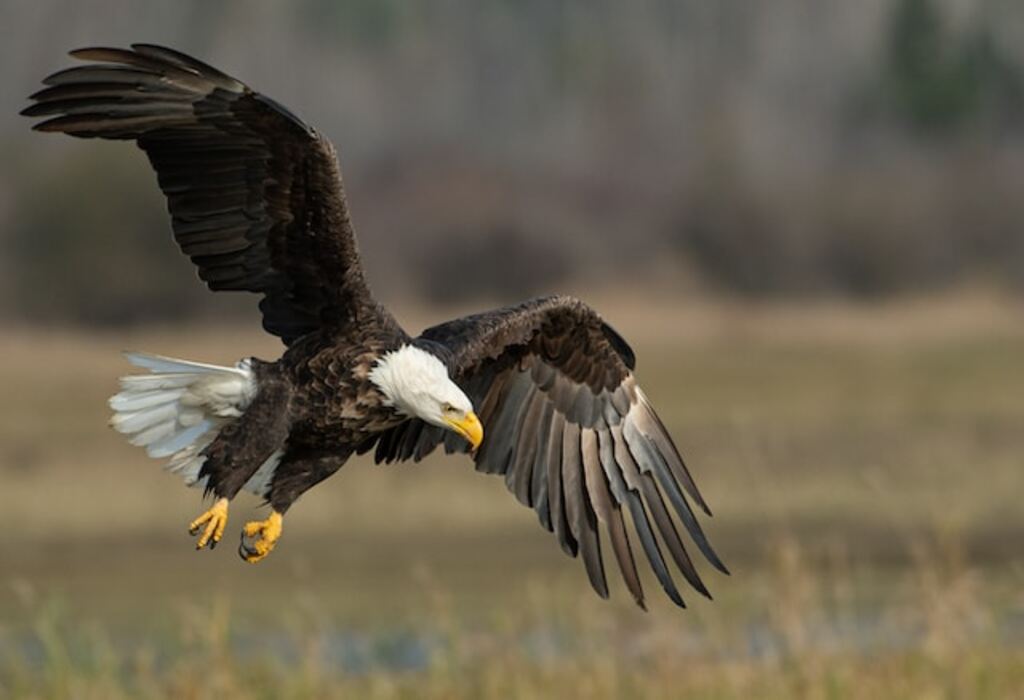
Frequently Asked Questions
What is the average lifespan of an eagle?
The average lifespan of an eagle varies depending on the eagle population and environmental factors. Factors such as habitat quality, availability of prey, and human activities can influence their lifespan. Understanding these factors is crucial for conservation efforts.
How do eagles develop their white head feathers?
Eagle plumage development involves a gradual transformation of feathers. The head feathers of eagles, including the development of their white coloration, occur over time as the bird matures, indicating age and maturity.
Are there any health issues or diseases associated with eagles’ head color change?
There are no known health issues or diseases directly associated with the color change of eagles’ head feathers. However, it is important to note that the transition from dark to white plumage occurs gradually and is a natural process.
Is it possible for an eagle’s head to turn white at a different age than usual?
The coloration of an eagle’s head can be influenced by genetic factors, resulting in variations in the timing of white plumage. These variations demonstrate the complexity of the genetic mechanisms involved in eagle head coloration.
How do eagles’ head color changes affect their mating behavior?
The color changes in eagles’ heads have been observed to influence their mating behavior. This is due to the fact that the color of their heads is associated with their habitat preference and feeding habits.

